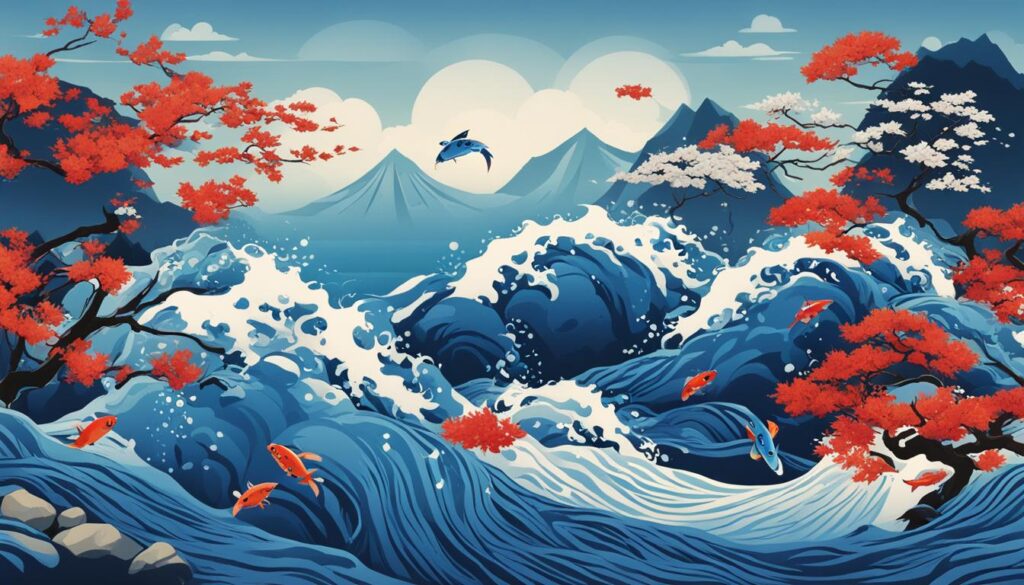In Japanese, the symbol for water is represented by the kanji 水. This symbol holds deep cultural and contextual significance, and understanding its meaning and usage can enhance your understanding of Japanese language and culture.
The kanji 水 is pronounced as “mizu” in the kun’yomi (Japanese reading) and “sui” in the on’yomi (Chinese reading). It consists of only 4 strokes, making it one of the simpler kanji characters. The shape of 水 is derived from a pictogram representing flowing water, evoking its ability to flow and pass through openings.
Water is highly valued in Japanese culture as a source of life and purity. It is associated with clarity, calmness, and pristine qualities. In Shinto purification rituals, water is used to cleanse and purify both individuals and objects.
The kanji 水 also serves as a radical, appearing in many other kanji characters related to water or liquid. Its versatility allows it to convey a variety of meanings in different contexts. In Japanese writing, 水 is a fundamental element, frequently used in compound words and names.
By understanding the meaning and cultural significance of the symbol for water in Japanese, you can deepen your appreciation for the language, its usage, and the values it represents.
The Symbolism of Water in Japanese Culture
In Japanese culture, water holds deep symbolism and is revered for its significance in various aspects of life.
Water is seen as the source of life, embodying purity, clarity, and calmness. It is considered an essential element in Shinto purification rituals, where it is used to cleanse and purify individuals as well as sacred objects.
Water’s symbolism extends beyond religious practices and is integrated into everyday life, as reflected in Japanese proverbs and sayings. For example, the saying “Flowing water does not rot” emphasizes the importance of maintaining an active and dynamic approach to life, rather than becoming stagnant. It signifies the need to embrace change and adaptability to avoid stagnation and decay.
Another widely-known proverb is “After the rain, the earth hardens.” This saying suggests that challenges and difficulties can lead to personal growth and inner strength, emphasizing the transformative power of overcoming obstacles.
The profound symbolism of water is also evident in the kanji character 水, which represents water in the Japanese writing system. This character is highly regarded and commonly used in Japanese culture, including in the naming of both individuals and families. The simplicity and expressive brush strokes of the 水 character make it a preferred choice for practice in the art of Japanese calligraphy.
To further understand the cultural importance of water in Japan, it is beneficial to explore the integration of water symbolism in various aspects of Japanese art, literature, and traditional ceremonies. From the serene landscapes depicted in ukiyo-e prints to the tranquil gardens of Zen temples, water is a recurring element that enhances the harmonious ambiance and reflects the Japanese appreciation for natural beauty.
Water Symbolism in Japanese Art
Japanese art frequently portrays water as a symbol of serenity, purity, and profound natural beauty. The mesmerizing art form of suibokuga, black ink painting, often incorporates water as a central theme. Artists skillfully manipulate brushstrokes to bring the fluidity and motion of water to life, creating a sense of calmness and tranquility. In traditional Japanese gardens, water features such as ponds, streams, and waterfalls are meticulously designed to create a serene atmosphere, inviting contemplation and a deep connection with nature.
| Symbolic Meanings of Water in Japanese Art | Representative Works |
|---|---|
| Renewal and Rebirth | The Great Wave off Kanagawa by Hokusai |
| Transience and Impermanence | Cherry Blossoms at Yoshino by Hiroshige |
| Harmony and Balance | Garden pond in Katsura Imperial Villa |
Water’s symbolism in Japanese culture is a testament to the profound connection between the people and their natural surroundings. It serves as a reminder to appreciate the endless flow of life, the cleansing power of change, and the serene beauty found in simplicity.
Kanji Characters Utilizing the Water Radical

In Japanese kanji characters, the water radical 水 is commonly used as a component or radical to convey meanings related to water, liquid, and other associated concepts. This radical symbolizes fluidity, purity, and change. Here are some examples of kanji characters where the water radical appears:
| Kanji Character | Meaning |
|---|---|
| 江 | river, estuary |
| 油 | oil |
| 消 | extinguish, disappear |
| 清 | pure, cleanse |
| 温 | warm |
| 泳 | swim |
| 湖 | lake |
The water radical 水 appears as a component in a total of 101 kanji characters. Its usage extends to commonly used characters like 温, 泳, and 湖. These characters incorporate the concept of water into their meanings, representing various aspects related to water and liquid in the Japanese language.
The Use of 水 in Japanese Compounded Kanji Characters
The kanji 水 is used in various contexts in the Japanese language, not just to describe water itself but also in words that convey related concepts. There are 599 Japanese words that begin with the kanji 水, and it appears in a total of 1239 words. Examples of compound words that include the kanji 水 are 水曜日 (Wednesday), 水中 (underwater), 水道 (water supply), and 水面 (water’s surface). These examples demonstrate the versatility of the kanji 水 in the Japanese language, extending from literal references to water to metaphorical and descriptive uses.
Five Elements in Japanese Buddhist Thought
In Japanese Buddhist thought, the five elements are known as godai. These elements, namely earth (土), water (水), fire (火), wind (風), and void (空), have their roots in the Indian Buddhist concept of Mahābhūta and have been influenced by Chinese traditions. Over time, they became a significant part of Japanese tradition, culture, and indigenous folk religions.
The godai in Japanese Buddhist thought share similarities with the classical Greek philosophical elements but have their own symbolic representations and interpretations in Japanese Buddhism. Each element represents specific qualities and characteristics:
- Earth (土): Stability, groundedness, and stubbornness
- Water (水): Flow, adaptability, and tranquility
- Fire (火): Creativity, passion, and transformation
- Wind (風): Growth, wisdom, and change
- Void (空): The source of the human spirit and the concept of absence
These elements hold deep symbolism and spiritual significance in Japanese Buddhist thought, shaping the understanding of the world and human nature. They are often incorporated into rituals, practices, and art forms, enriching the cultural landscape of Japan.
Integrating the 五大 into Japanese Language Learning
To improve your Japanese fluency, you can incorporate the concept of 五大 (godai), the five elements, into your language learning journey. An effective way to start is by observing how native speakers naturally incorporate the elements into their conversations. By paying attention to the context and usage of the elements in authentic Japanese videos and audios, you can gain a better understanding of how they are used in everyday speech.
FluentU is a valuable resource that can help you find video content that showcases the five elements in action. By watching these videos, you can see firsthand how the 五大 are integrated into real-life situations, enhancing your comprehension and language skills.
Another strategy is to practice conversations that incorporate the 五大. Familiarize yourself with common phrases and expressions that reflect the qualities and characteristics associated with each element. By incorporating these phrases into your own conversations, you can add personality and depth to your Japanese speech.
By understanding and using the 五大, you can elevate your Japanese language learning experience and develop a deeper connection to the culture. Embracing the five elements adds another dimension to your language skills, allowing you to express yourself more effectively and authentically in Japanese.



